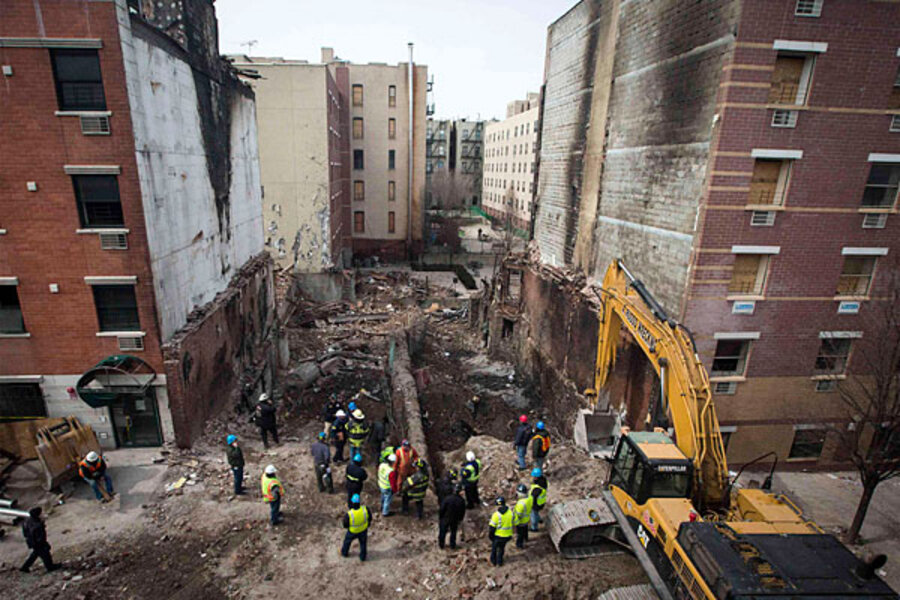Harlem gas explosion: How widespread is the problem?
Loading...
| New York
Two century-old East Harlem tenements were completely destroyed on March 12 after a natural gas leak sparked an explosion that leveled the five-story brick building, killing eight people and injuring more than 60 others. The buildings were part of a bustling area on the northern reaches of Manhattan’s famed Park Avenue, housing working-class families as well as the store-front sanctuary of a Spanish-language church and a piano repair store.
1. What happened, exactly?
As of Monday, city officials and federal investigators from the National Transportation Safety Board, which probes all serious gas-line incidents, had yet to begin their investigation into the exact cause of the leak and subsequent explosion. New York City firefighters were still removing rubble from the explosion site.
But residents and neighbors say they had complained numerous times about the smell of leaking gas – including a call just minutes before the Wednesday morning blast that sent tons of debris onto the streets and the elevated commuter railroad tracks directly across the street. More than 100 residents of nearby buildings remain homeless.
2. Is natural gas inherently more dangerous than home heating oil?
The vast majority of fatalities and injuries related to the nation’s network of fuel-delivery pipelines (both oil and natural gas) are gas-related. In 2013, there were 10 fatalities and 46 injuries related to pipeline-related incidents, and nine of the deaths and 39 of the injuries were caused by gas-delivery pipelines, according to the federal Pipeline & Hazardous Materials Safety Administration. Even a small gas leak in an enclosed space can spark a catastrophic explosion. During the past 10 years, gas explosions have caused an estimated $75 million a year in property damages.
3. How widely is natural gas used in the US?
By almost every measure, natural gas is cheaper, cleaner-burning, and more efficient than other heating fuels. For every $100 spent for natural gas, a household or business would spend around $350 for oil or electric heating, according to the US Energy Information Administration.
In all, natural gas accounts for almost one-fourth of total US energy consumption, with more than 71 million residential, commercial, and industrial natural gas customers, according to the American Gas Association. And these numbers are quickly growing. The US consumed 26 trillion cubic feet of natural gas in 2013, up 20 percent from 2003, according to the federal pipeline safety administration.
4. What is the state of natural-gas infrastructure?
The gas main serving the two Harlem tenements in New York was a 127-year-old cast iron pipe – the kind most prone to corrosion, cracking, and subsequent leaks, experts say. New York City has more than 6,300 miles of natural gas pipelines with an average age of 56 years.
In the first half of the 20th century, cast iron was used for the nation’s natural gas infrastructure, primarily in urban areas. But in the 1950s, steel, with greater strength and flexibility, became the material of choice, especially for “long haul” pipes, mostly underground and including almost a quarter of a million miles of the US infrastructure.
For the last 30 years, however, plastic piping, the safest, has been used for gas utility distribution systems operating at less than 100 pounds of pressure. In 2003, plastic pipe accounted for a half million miles of gas mains, according to the AGA.
5. Is there anything a resident can do to make sure pipes are maintained?
Homeowners and businesses can contact their utility, local municipality, or state regulatory agency for records of all recent inspections – as well as the age and material used for the local infrastructure. Many experts, however, say that utilities have begun to cut staff in recent years, relying more on private companies to inspect and maintain pipes. And former industry officials often direct regulatory agencies, experts say, arguably leading to conflicts of interest.
If any person smells gas in their home or business, they should contact their utility immediately.








